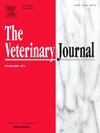刚地弓形虫改变猫的肠道微生物群和全身代谢:一种多组学方法。
IF 3.1
2区 农林科学
Q1 VETERINARY SCIENCES
引用次数: 0
摘要
刚地弓形虫(T. gondii)是一种专性细胞内寄生虫,具有复杂的生命周期,其最终宿主是猫。虽然它的免疫学影响已经得到了很好的研究,但弓形虫是如何塑造猫的肠道微生物群和全身代谢的,在很大程度上仍未被探索。为了研究宿主-寄生虫-微生物组的相互作用,我们对感染弓形虫前后的猫进行了多组学研究,结合宏基因组测序和非靶向血清代谢组学。粪便样本用于构建全面的微生物基因目录并评估功能变化,而血清样本通过液相色谱-串联质谱(LC-MS/MS)分析以捕获系统代谢变化。弓形虫感染,特别是在其有性复制阶段,会显著破坏肠道微生物的多样性、组成和功能。功能注释显示参与维生素、辅助因子和能量代谢的微生物基因下调,同时碳水化合物代谢途径上调。同时,代谢组学分析显示了脂质谱、氨基酸途径和叶酸介导的单碳代谢的显著改变。综合分析揭示了特定微生物类群(如青少年双歧杆菌和动物脂乳杆菌)与宿主代谢物之间的强相关性,强调了微生物功能与宿主对感染的代谢反应之间的紧密联系。据我们所知,这是第一个全面绘制猫宿主中弓形虫感染的微生物群和代谢景观的研究。我们的研究结果揭示了寄生虫诱导的微生物功能和全身代谢的深刻变化,为宿主、寄生虫和微生物群之间的分子相互作用提供了新的见解。这些见解可能为弓形虫病中宿主反应的治疗调节提供未来的策略。本文章由计算机程序翻译,如有差异,请以英文原文为准。
Toxoplasma gondii alters gut microbiota and systemic metabolism in cats: A multi-omics approach
Toxoplasma gondii (T. gondii) is an obligate intracellular parasite with a complex life cycle that culminates in cats—its only definitive host. While its immunological impact is well studied, how T. gondii shapes the feline gut microbiota and systemic metabolism remains largely unexplored. To investigate host–parasite–microbiome interactions, we performed a multi-omics study combining metagenomic sequencing and untargeted serum metabolomics in cats before and after T. gondii infection. Fecal samples were used to construct a comprehensive microbial gene catalog and assess functional shifts, while serum samples were analyzed via liquid chromatography-tandem mass spectrometry (LC-MS/MS) to capture systemic metabolic changes. Infection with T. gondii, particularly during its sexual replication phase, significantly disrupted gut microbial diversity, composition, and function. Functional annotation revealed downregulation of microbial genes involved in vitamin, cofactor, and energy metabolism, alongside upregulation of carbohydrate metabolism pathways. Concurrently, metabolomic profiling showed marked alterations in lipid profiles, amino acid pathways, and folate-mediated one-carbon metabolism. Integrated analysis uncovered strong correlations between specific microbial taxa—such as Bifidobacterium adolescentis and Ligilactobacillus animalis—and host metabolites, underscoring a tight link between microbial function and host metabolic responses to infection. To our knowledge, this is the first study to comprehensively map the microbiome and metabolic landscape of T. gondii infection in the feline host. Our findings reveal profound parasite-induced shifts in microbial function and systemic metabolism, offering new insights into the molecular interplay between host, parasite, and microbiota. These insights may inform future strategies for therapeutic modulation of host responses in toxoplasmosis.
求助全文
通过发布文献求助,成功后即可免费获取论文全文。
去求助
来源期刊

Veterinary journal
农林科学-兽医学
CiteScore
4.10
自引率
4.50%
发文量
79
审稿时长
40 days
期刊介绍:
The Veterinary Journal (established 1875) publishes worldwide contributions on all aspects of veterinary science and its related subjects. It provides regular book reviews and a short communications section. The journal regularly commissions topical reviews and commentaries on features of major importance. Research areas include infectious diseases, applied biochemistry, parasitology, endocrinology, microbiology, immunology, pathology, pharmacology, physiology, molecular biology, immunogenetics, surgery, ophthalmology, dermatology and oncology.
 求助内容:
求助内容: 应助结果提醒方式:
应助结果提醒方式:


